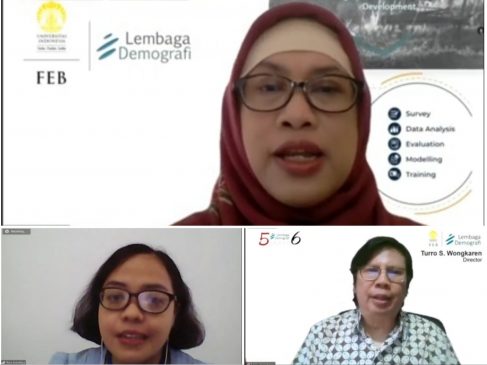Special Webinar LD FEB UI 56 Years: Elderly Welfare Movement in Anticipation of the Second Demographic Bonus
Nino Eka Putra ~ PR of FEB UI
DEPOK – (25/8/2020) In commemoration of its 56th Anniversary, the Demographic Institute of the Faculty of Economics and Business, Universitas Indonesia (LD FEB UI) held a special webinar in collaboration with the Development Study Forum (FKP), entitled “The Older-Person Welfare Act in Anticipation of the Second Demographic Bonus” on Tuesday (25/8/2020).
The resource person for this webinar was Dr. Lilis Heri Mis Cicih, M.Sc., LD FEB UI Senior Researcher, hosted by Turro S. Wongkaren, Ph.D., Head of LD FEB UI and moderated by Flora Aninditya M.S.E., LD FEB UI researcher.
Lilis Heri Mis Cicih, said that the aging population of Indonesia is shown by the increase in the number and proportion of the elderly population. To anticipate the second demographic bonus era, it is necessary to improve the quality of human resources. The current socio economic condition of the elderly is still unsatisfactory, and many adults currently do not have social and economic security when they reach old age.

The current Law Number 13 Year 1998 regarding the welfare of the elderly is outdated and needs to be updated to be in line with changing socio economic conditions and the aging paradigm. “The Draft Law (RUU) on the welfare of the elderly needs to be improved, especially the right to improve the social welfare of the elderly. The division of categories of potential and non-potential elderly needs to be reviewed, that the elderly should be seen as a process (aging ), need to be reexamined regarding age boundaries, and the approach to handling the elderly must look at the relationship between generations, not only focused on the elderly. ” said Lilis.
Based on data from the Central Statistics Agency (BPS), Susenas March 2019, it is said that there are 9.60% or 25.66 million elderly in Indonesia. The elderly group is divided into 3 categories, the first is regional type (urban 52.80% and rural 47.20%). Second, gender (male 47.65% and female 52.35%). Third, the age group (young elderly 60-69 years at 63.82%, middle elderly 70-79 years at 27.68%, elderly 80 years and over at 8.50%).
Five provinces in Indonesia have an aging population structure (BPS 2019), including the Special Region of Yogyakarta 14.50%, Central Java 13.36%, East Java 12.96%, Bali 11.30%, and North Sulawesi 11.15% . In addition, only around 12 out of 100 elderly households in Indonesia have social security, including pensions, old age benefits, work accidents, death, and termination of employment (PHK).
“So, the National strategy for sustainability prepared by the government is the principle of being independent, prosperous and dignified. The Elderly have the right to live and need to create a kind of Movement for the Elderly, because the elderly are us and all the elderly are our parents. We strive for better living conditions for the elderly to prepare a superior generation in the future,” explained Lilis at the end of her presentation. (hjtp)
(am)




